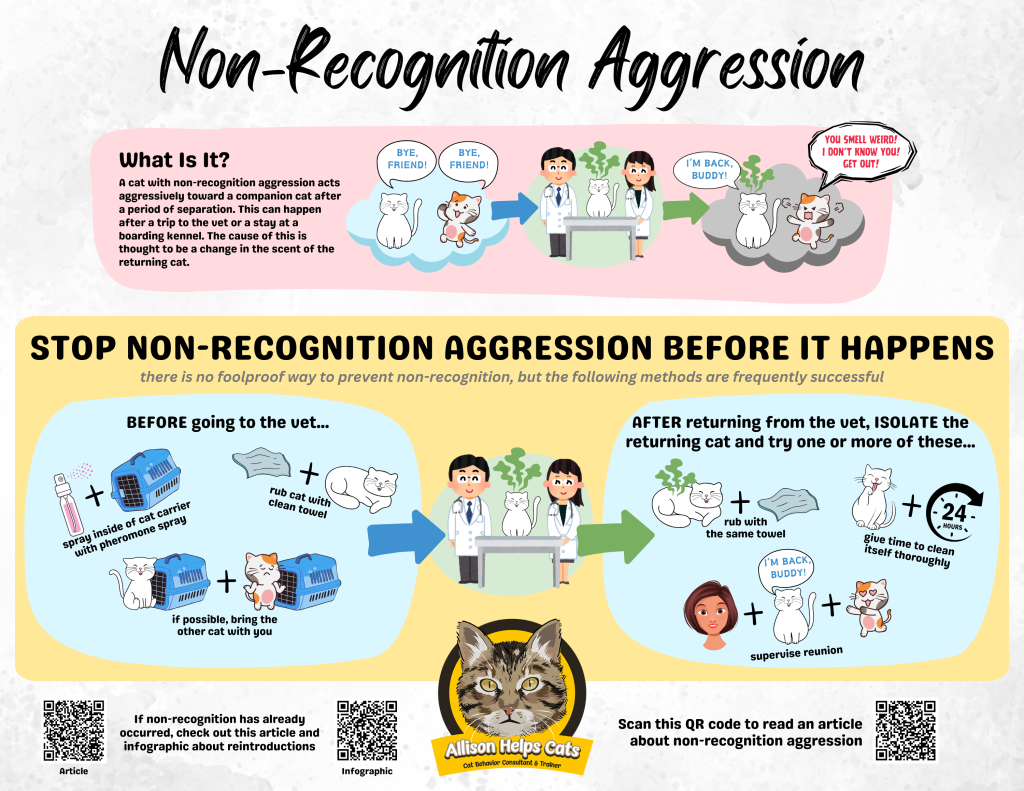Pets and Their People Blog
Sudden Tension Between Cats: Could It Be Non-Recognition Aggression?
Each year, countless cats and their guardians are affected by non-recognition aggression, a phenomenon in which a cat returning home from an outing is suddenly treated as an intruder by a cat who remained at home.
This situation often occurs after a visit to the vet, but it can also happen after a trip to the groomer, an outdoor excursion, or a visit to a home with dogs. Experts believe scent plays a key role in triggering non-recognition aggression.
If left unaddressed, the at-home cat may attack the returning cat, who might then respond defensively, not understanding what triggered the aggression. This misunderstanding can quickly escalate into a fight. The more frequently cats engage in fights, the more strained their relationship becomes, increasing the likelihood that aggression will become a pattern.
Prevention
While there are no surefire ways to prevent non-recognition aggression, some techniques have proven more effective than others. One approach is to take both cats on outings together, thereby exposing them to the same scents. If that’s not possible, it can help to rub a clean towel on the departing cat, and upon returning rub the same towel on the cat to reapply the familiar scent.
Additionally, keeping the returning cat in a separate room for a few hours or days allows the cat time to fully groom, further restoring their original scent.
Resolution
If non-recognition aggression occurs, the best approach is to reintroduce the cats. When our family first experienced non-recognition aggression, we used what I call a “mini-introduction” to resolve it. We followed the standard reintroduction steps but on a shorter timeline, taking only a few days instead of a few weeks. Occasionally, there were times when everything seemed fine until the resident got close to the cat who had left our home. At that point, it appeared that a lingering unfamiliar scent had become more noticeable to her, which triggered a reaction. Despite these incidents, most of our early cases of non-recognition aggression were resolved within a few days or weeks.
Why do some cases take longer to resolve than others? Some feline behavior consultants suggest that if there was previous tension between the cats, reuniting them may take longer—if it happens at all.
Another key factor is the health of the cat who left the home. A few years ago, after our oldest cat had an extended stay at the vet, our family had to completely separate our younger cat Rainy from our other cats for a full reintroduction. I believe two factors contributed to this setback. First, I’ve noticed that the length of separation often plays a role in how easily relationships can be restored. Second, when she was reintroduced to Rainy, the older cat who had been at the vet, was still not feeling her best. Her reaction seemed defensive, as she may have felt more like prey.
When we faced a prolonged case of non-recognition aggression in our home, I conducted a small survey of other cat owners. Many had successfully reunited their cats, some had only managed a partial reconciliation, and others were still living with permanently separated cats. These experiences highlight how crucial it is to address non-recognition aggression as soon as possible.
The sooner intervention begins, the greater the chance of a full resolution and a restored bond between the cats.
Advocacy and Education
If you have questions about non-recognition aggression or would like to share your own experiences, I’d love to hear from you. Our family has been deeply affected by this problem, which is why I’m so passionate about advocating for it.
My husband and I have created an infographic on the topic that we’d love to see in every vet office and shelter (see below).

I continue to push for greater education on this subject so that other families can either avoid this phenomenon or be better prepared to handle it.
About the Author

Allison Hunter-Frederick Certified Cat Behavior Consultant and Trainer. She is also the wife of a supportive husband who designs her social media, mom to four fur kids and revolving fosters, and the cat enrichment and post-adoption coordinator for her local humane society. Through her business Allison Helps Cats LLC , she uses her knowledge of cats to help cat owners and animal shelters with their cat behavior needs. She is an advocate for creating awareness about non-recognition aggression.

